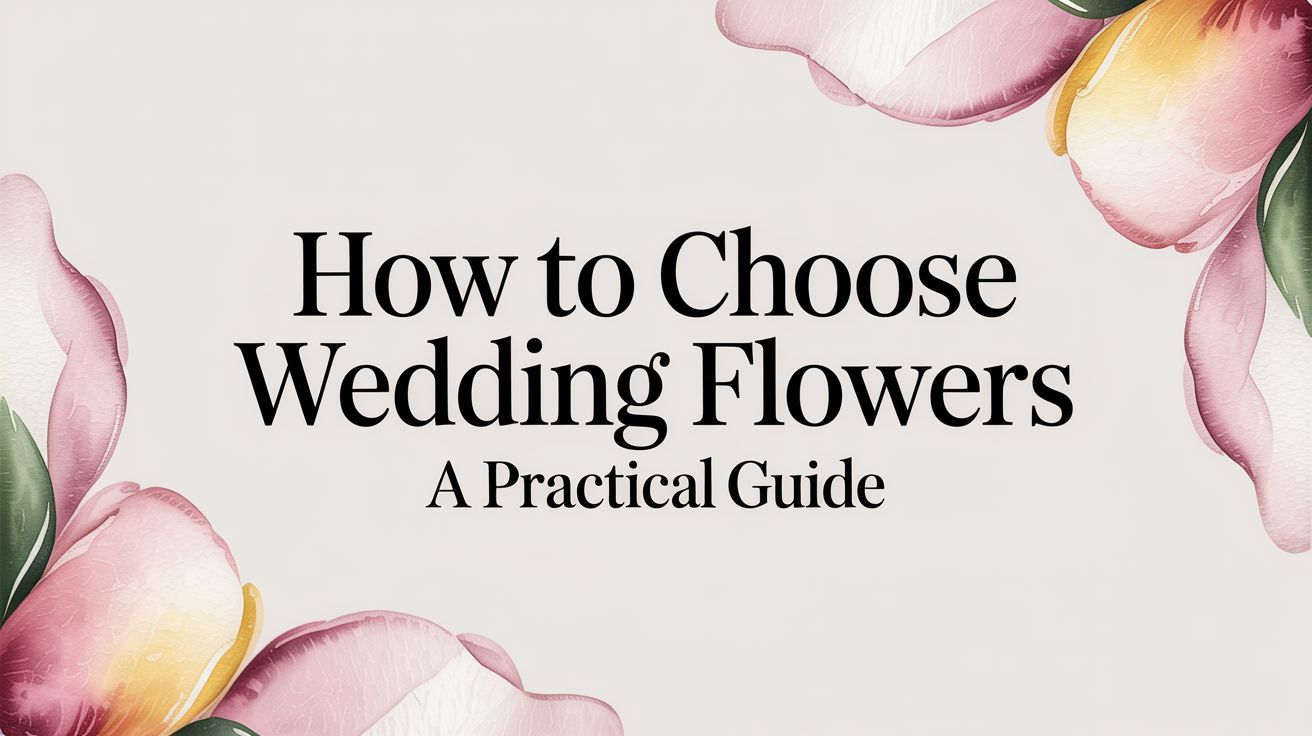Before you even think about specific flowers, the first, most crucial step is to get a crystal-clear picture of your overall wedding aesthetic. This is what I call creating your 'floral blueprint.' Without this foundation, you’ll quickly find yourself lost in a sea of pretty-but-overwhelming options.
The goal here is to craft a cohesive vision that will guide every single floral decision you and your florist make together.
Translating Your Vision into a Floral Blueprint
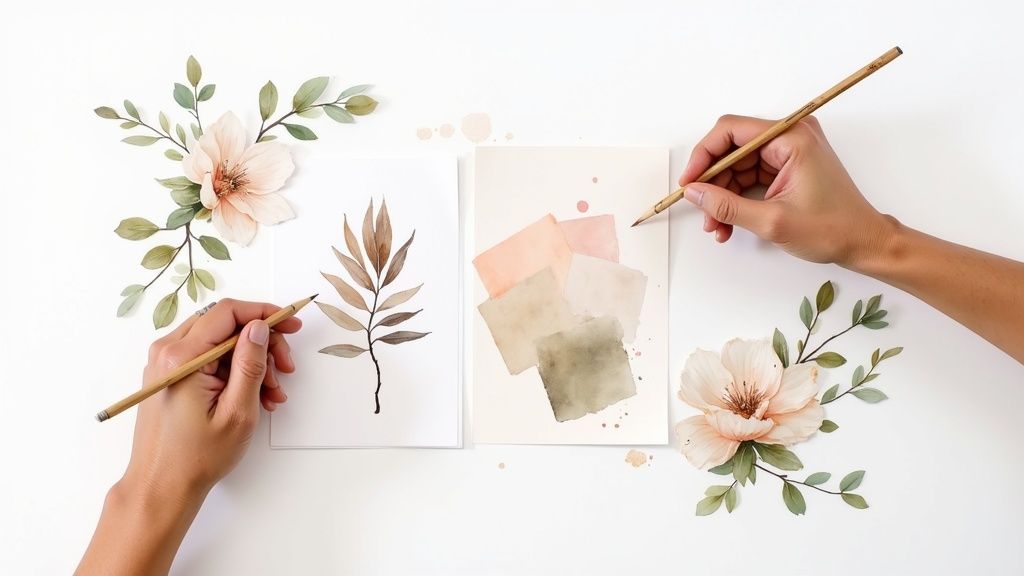
Inspiration for this blueprint can, and should, come from everywhere—not just the usual wedding magazines or a Pinterest rabbit hole. Often, the most authentic and meaningful ideas are hiding in plain sight, woven into the fabric of your wedding story.
Take a look at the elements you've already chosen:
- Your Venue's Atmosphere: A grand, historic ballroom naturally calls for classic, more structured arrangements. But if you're getting married in an industrial loft, you might lean into minimalist, sculptural florals. Let the space speak to you.
- Your Attire's Style: Is your dress covered in delicate, vintage-style lace? Soft, romantic blooms like garden roses will complement it beautifully. For a sleek, modern gown, you might consider bold, architectural flowers like calla lilies or orchids.
- A Cherished Memory or Place: Maybe that unforgettable trip to Italy inspires a bouquet filled with olive branches and rich, Tuscan-hued roses. Or perhaps a memory of your grandmother’s garden makes you want to include a few specific heirloom flowers that feel like home.
Create a Cohesive Mood Board
Once you start gathering ideas, a mood board becomes your single most powerful communication tool. Think of it as more than just a collage of flower photos; it's a visual summary of the feeling you want to create on your wedding day.
I always advise clients to curate a tight collection of 8-10 core images that truly capture the mood, color palette, and textures they're drawn to. Be sure to include photos of your venue, your dress, and even non-floral things like a piece of art or an interior design shot that reflects your style.
A great mood board doesn't just show a florist what you like—it shows them how you want your wedding to feel. It helps them understand if your vision is "airy and romantic" or "dramatic and moody."
Use Words That Work
Beyond the visuals, learning how to describe your vision with words is invaluable. You don't need to know the name of every single flower, but being able to articulate the aesthetic you're after makes a world of difference.
Try using descriptive pairings to get more specific. For example, instead of just saying "modern," clarify if you mean:
- Modern and Sculptural (This implies clean lines, unique shapes, and minimal foliage.)
- Modern and Romantic (This suggests a beautiful blend of clean design with softer, fuller blooms.)
This level of detail gets everyone on the same page instantly. For an even more personal touch, some couples love incorporating birth month flowers, which adds another layer of unique meaning to the day.
This blueprint sets the stage for a floral story that feels consistent, intentional, and genuinely yours.
Making Your Floral Budget Work for You
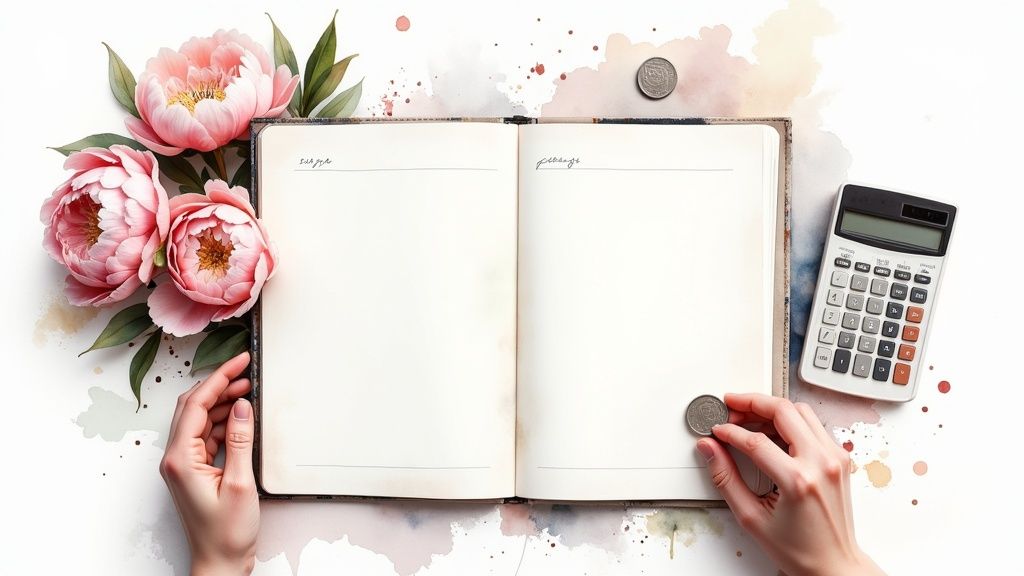
Let's get real about money. It’s so easy to get swept away by dreamy floral inspiration on Pinterest, but setting and understanding your budget is what will keep your wedding planning joyful, not stressful. Think of flowers as an investment in your wedding's entire atmosphere—they're what bring the whole vibe to life.
First off, it’s crucial to know what you’re actually paying for. It isn't just the price of the stems. Your floral bill covers your florist’s design expertise, the labor for setup (which can take hours!) and breakdown, transportation, and all the vases, vessels, and hidden mechanics that make those arrangements look effortless.
Globally, the wedding flowers market is valued at over $4.1 billion as of 2024, and it's only expected to grow. This just goes to show how central florals have become to the modern wedding experience. If you’re trying to keep all your expenses organized, there are some fantastic wedding planning apps to manage your budget that can give you a clear picture of where every dollar is going.
Where to Focus Your Funds for the Biggest Impact
Not all floral moments are created equal. To get the most bang for your buck, you'll want to concentrate your spending on the key areas that get the most eyeballs and camera time.
- Your Personal Flowers: This means your bouquet, your partner's boutonnière, and anything for the wedding party. These pieces are non-negotiable and will be in almost every single portrait, so this is where you want to prioritize quality and get exactly what you want.
- The Ceremony Focal Point: Whether it’s a breathtaking floral arch, a dramatic altar installation, or lush aisle markers, this is what sets the entire tone for your day. It’s the backdrop for your "I dos," after all!
- Reception Centerpieces: These arrangements are what your guests will be admiring all evening long. They have a massive impact on the overall feel of the reception and are a huge part of the guest experience. You can find some beautiful ideas in our guide to wedding centerpiece flower arrangements.
A Little Insider Advice: Don't fall into the trap of trying to spread your budget thinly across every single surface. It’s so much more impactful to have a few absolutely incredible, show-stopping floral installations than dozens of small, forgettable arrangements.
How to Allocate Your Budget
To give you a clearer idea of where the money goes, I've put together a sample breakdown. This is just a guide, of course, and your florist can help you customize it based on your specific priorities.
Sample Wedding Flower Budget Allocation
Here's a percentage-based guide to help you plan where your floral funds might go.
| Floral Item | Average Budget Percentage | Cost-Saving Tip |
|---|---|---|
| Personal Flowers | 10-15% | Choose in-season flowers for bouquets and boutonnières. |
| Ceremony Decor | 20-30% | Repurpose ceremony arrangements for the reception. |
| Reception Decor | 40-50% | Mix high-cost and low-cost centerpieces. |
| Cocktail Hour & Other | 5-10% | Use bud vases with single stems for smaller tables. |
| Delivery & Setup | 10-15% | This is a fixed cost; focus savings on the flowers themselves. |
Remember, this is a starting point. If a massive, jaw-dropping ceremony arch is your number one dream, you might allocate more there and scale back a bit on cocktail hour decor.
Smart Ways to Maximize Your Investment
Getting the most from your budget isn’t about being cheap; it's about being clever. A great florist is a creative problem-solver who can help you achieve a luxe look without breaking the bank.
One of the best strategies we use is repurposing arrangements. That stunning floral arch from your ceremony? Let's move it behind your head table at the reception. Those gorgeous bridesmaid bouquets? We can pop them into vases to decorate the cake table, guest book area, or bar. This simple trick gives your most beautiful blooms a second moment to shine.
Another approach I love is to mix high-end flowers with more affordable, but equally beautiful, ones. If you have your heart set on expensive peonies, let's make them the star of your bouquet but fill out centerpieces with lush garden roses, fluffy carnations, or elegant stock.
The key is an open, honest conversation with your florist from day one. When you're transparent about your budget, you empower them to find creative solutions and guide you toward the best seasonal options, ensuring your final floral design is everything you dreamed of and financially comfortable.
Choosing Flowers Aligned with the Season
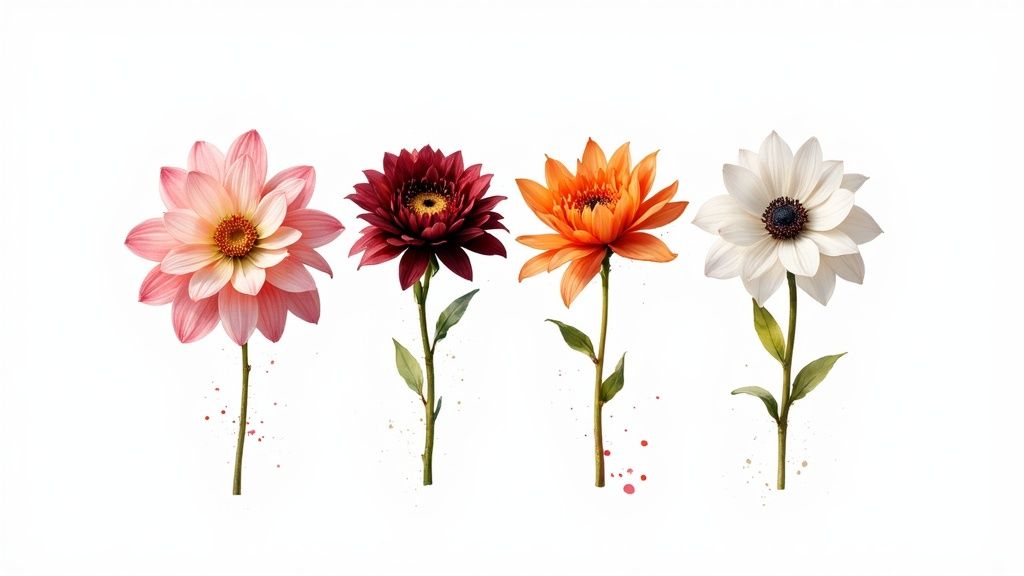
If I could give couples just one piece of advice that would completely transform their floral experience, it would be this: work with the seasons, not against them. Seriously. This is probably the single most impactful decision you can make, and it affects everything from the freshness of your arrangements to the final number on your invoice.
When flowers are in their natural growing season, they are at their absolute peak. This means they're more vibrant, more fragrant, and far more robust. The result? Arrangements that look fuller and last longer throughout your big day.
Sourcing seasonal blooms, especially from local growers, also slashes transportation costs and reduces your wedding's environmental footprint. It’s a move that’s both sustainable and budget-friendly.
This isn't just a practical tip; it's a global trend. The U.S. cut flower market is growing at an annual rate of 5.5%, and a lot of that growth is driven by weddings and a real desire for more sustainable practices. Couples are actively seeking out locally grown, seasonal flowers. If you're curious about the industry shifts, you can find more insights on the cut flower market at maximizemarketresearch.com.
A Walk Through the Floral Calendar
Getting a feel for what’s available during your wedding month is crucial. It helps manage expectations and, honestly, it can open your eyes to stunning options you might never have considered. You might have your heart set on peonies, but if you're planning a November wedding, your florist will have to source them from halfway across the world. They'll come with a premium price tag, and their quality just won't compare to a locally grown June peony.
Let’s take a quick look at what each season brings to the table:
- Spring (March - May): This season is all about lush, romantic, and delicate blooms. Think fragrant sweet peas, elegant tulips, cheerful daffodils, and of course, the highly sought-after peony.
- Summer (June - August): Summer is an explosion of color and texture. You'll find vibrant dahlias, cosmos, zinnias, and classic garden roses in absolute abundance, perfect for creating bold, beautiful arrangements.
- Fall (September - November): Autumn offers such a rich, moody palette with incredible texture. We love working with deep-hued chrysanthemums, textural foliage, and dramatic dahlias that thrive in the cooler weather. For more inspiration, check out our guide to stunning fall wedding flower ideas.
- Winter (December - February): Winter florals are just so elegant and resilient. Anemones with their striking dark centers, festive amaryllis, and fragrant paperwhites come together to create a sophisticated and timeless look.
When you embrace what’s in season, you're aligning your wedding with the natural rhythm of the world. It not only guarantees the best possible quality but also ensures your floral decor feels authentic and perfectly suited to the time of year.
Beyond the Obvious Choices
Working with the season doesn’t mean you’re limited. In fact, it often forces us to be more creative, which is where the magic really happens. A great florist will introduce you to unique, in-season alternatives that capture the same vibe as a more popular, out-of-season flower you might have had in mind.
For example, say you love the delicate, ruffly look of a ranunculus but are getting married in late summer when they aren't available. A talented designer might suggest a gorgeous lisianthus or a specific variety of spray rose to achieve a similar romantic effect.
Being flexible is the key to creating a design that is both breathtaking and sensible. Ultimately, letting the season guide your choices is a strategic move that pays off in beauty, your budget, and your peace of mind.
Crafting Your Perfect Wedding Color Palette
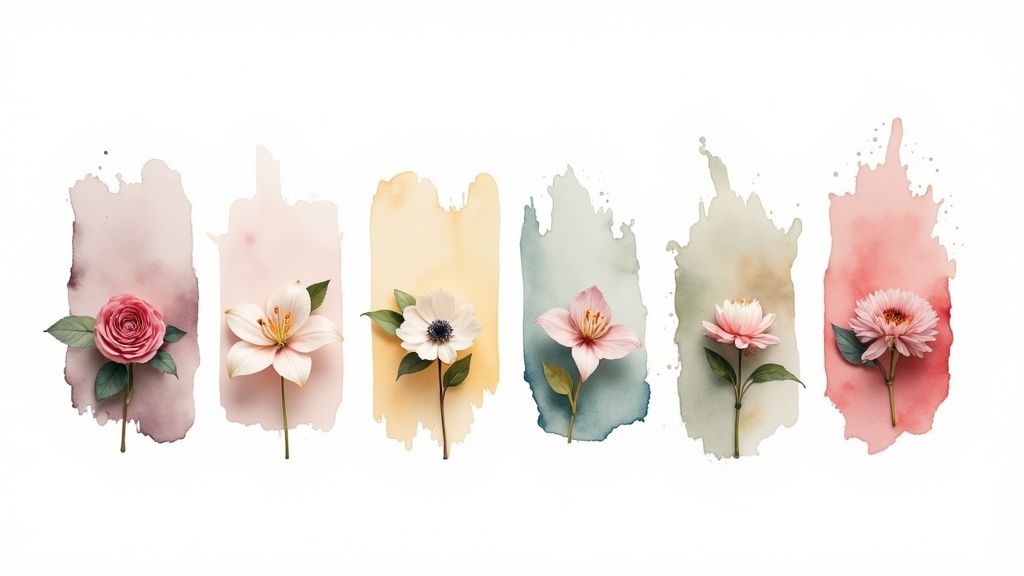
Your color palette is the emotional heartbeat of your wedding, and flowers are the most powerful way to bring that feeling to life. A truly sophisticated palette goes way beyond just picking one or two of your favorite colors; it’s about adding depth and personality that flows through your entire day.
Think of it like an artist's canvas. Your florist will use color to set a specific mood—be it romantic and soft, bold and dramatic, or bright and cheerful. The goal here is to build a cohesive color story that feels intentional, personal, and completely unforgettable.
Building a Sophisticated Palette
A great wedding color palette isn't flat; it has layers. To create this richness, I always advise my clients to think in terms of three tiers of color that work together in harmony.
- Primary Color: This is your main, most dominant hue. It's the one you'll see in major elements like bridesmaid dresses or table linens.
- Secondary Color: This color is there to support your primary shade. You’ll use it more sparingly, but it should still be prominent enough to create balance and keep things interesting.
- Accent Color: Here’s your "pop" of personality! Used in the smallest quantities, it prevents the palette from feeling one-dimensional and really catches the eye. It often shows up in bouquets, boutonnieres, or small decor details.
This tiered approach is exactly how designers create palettes that feel so rich and professionally styled. For instance, a primary dusty blue and a secondary cream are beautifully elevated by a warm terracotta accent. It just works.
Using Color Theory to Set the Mood
Honestly, understanding a few basic color theory concepts can completely change how you approach your palette. The relationship between your chosen colors will dictate the entire feeling of your wedding.
A monochromatic palette uses different tones of the same color, like various shades of pink from the softest blush to a vibrant fuchsia. It’s an incredibly chic and unified look. An analogous palette, on the other hand, uses colors that are neighbors on the color wheel—think yellow, orange, and red—for a warm, cohesive feel.
Want something with more energy? A complementary palette uses colors that sit opposite each other on the wheel, like blue and orange. This high-contrast combination creates a vibrant, energetic, and bold atmosphere that makes a real statement.
Your venue is your unofficial fourth color. Take note of the colors of the walls, carpets, and existing decor. Your floral palette should enhance the space, not fight against it.
Finding Inspiration in Your Venue
Before you get your heart set on your colors, take a really close look at your venue's built-in palette. A grand ballroom with deep red carpets and gold drapery will clash with a pastel pink and blue theme. It would, however, look absolutely stunning with a complementary palette of rich burgundy, cream, and gold.
Let your venue’s inherent colors guide your choices. This is one of my biggest pieces of advice. It ensures your flowers feel like a natural extension of the space, creating a seamless and immersive experience for you and your guests. This strategic thinking is key when learning how to choose wedding flowers that truly elevate your day.
Finding and Partnering with Your Ideal Florist
Think of your florist less like a vendor and more like a creative partner. Seriously. They're the expert who will take your Pinterest board, your budget, and your daydreams and spin them into something real and breathtakingly beautiful. Finding a designer you genuinely click with is non-negotiable; their guidance can be the difference between a stressful planning process and a genuinely joyful one.
The hunt for "the one" usually starts online. Instagram and Pinterest are your best friends here, letting you discover designers whose style just feels right. A pro tip? Look for florists tagged in photos from your venue or by other vendors you already love. This is a great shortcut to finding people who know your wedding location inside and out and have already created magic there.
Vetting Potential Floral Designers
Once you have a shortlist of names, it's time to put on your detective hat and do a deep dive into their portfolios. Don't just scroll through the pretty pictures—really analyze what you’re seeing.
- Look for Consistency: Do they have a signature style you can spot from a mile away? Whether it's wildly romantic and lush or clean and modern, you want to see a clear creative voice that sings to you.
- Evaluate Variety: A strong portfolio should show off their work in different venues and with various color palettes. This proves they’re versatile and can think on their feet, which is exactly what you want.
- Check for Real Weddings: Styled shoots are gorgeous, but they don't tell the whole story. Real wedding galleries show how a florist handles the pressure and logistics of an actual event. Look for galleries that show everything from bouquets to the ceremony to the reception to see how they weave a cohesive floral story together.
Don't forget that where you're getting married matters. Different regions have completely unique floral markets and dominant styles. In North America and Western Europe, for instance, there's often a significant investment in premium, luxurious floral designs. The rise of online platforms has also made the industry more transparent, giving couples more direct access to florists and their pricing, shifting the focus from traditional brick-and-mortar shops. You can get a better sense of the wedding flowers market size on datainsightsmarket.com.
Mastering the Consultation
This is where the real connection happens. Your consultation is the ultimate vibe check—your chance to see if you and the florist have that creative spark. Show up prepared with your mood board and your budget, but also bring an open mind. A truly great florist won't just nod and agree with everything; they’ll listen intently and then offer their own expert suggestions to elevate your ideas.
The goal isn't just to find a florist who can execute your vision, but to find one who understands it. They should be asking thoughtful questions about your day, your style, and what's most important to you.
After your chat, you should receive a detailed proposal. This document should be so much more than a price list. It needs to break down every single floral element, from the specific flower types they're picturing to the vases and mechanics they'll use. A professional, thorough proposal is a huge green flag, showing you they're organized, detail-oriented, and have a solid plan to bring your vision to life.
Ultimately, choose the partner who makes you feel heard, understood, and genuinely giddy with excitement.
Answering Your Biggest Wedding Flower Questions
Even after you've pinned a hundred images to your mood board and picked the perfect florist, a few questions always seem to pop up. It's completely normal—navigating the world of wedding florals for the first time can feel like learning a new language. Let's clear up some of the most common queries so you can feel confident as your day gets closer.
One of the first things couples ask is, "How far in advance should we book our florist?" I always recommend starting the search about 9 to 12 months out. This gives you plenty of time to find a designer whose style truly speaks to you, especially if you have your heart set on someone in high demand or if you're planning a wedding during the busy season.
So, We Booked Our Florist. Now What?
Once you’ve signed the contract, the real fun begins. This is when the collaboration kicks into high gear. You’ll work closely with your designer to polish your vision, chat about which flowers will be at their peak during your wedding season, and lock in the final designs for everything from your bouquet to any show-stopping installations.
This creative process is where your ideas start to become a reality. Your florist will take all your inspiration and translate it into a detailed proposal, breaking down every single arrangement and what it will cost.
A little secret from inside the industry: you absolutely do not need to know the names of every flower you want. It’s so much more helpful to focus on the feeling, the color palette, and the overall style you’re going for. Trust your florist to suggest the perfect blooms to bring that vision to life—that's what we're here for!
Another big question is always about day-of logistics: "When do the flowers actually show up?" Your floral designer will handle all of this, creating a detailed delivery and setup schedule for the wedding day. It’s usually a multi-step process. We’ll bring the bouquets and other personal flowers to wherever you're getting ready, then head to the ceremony and reception venues to install the larger arrangements on-site.
A few other details to keep in mind:
- Bouquet Preservation: Thinking about saving your bouquet? Great idea! You can have flowers pressed, professionally freeze-dried, or even cast in resin. The key is to research and book a preservation specialist before the wedding.
- Final Guest Count: Your final table count directly affects how many centerpieces you’ll need. Most florists need this number about a month before your date to make sure they can finalize their flower order with their growers.
Getting these details sorted out ahead of time makes for a smooth, stress-free experience. If other questions pop up, your florist's website is a great resource. For instance, we’ve put together a whole page answering our most frequently asked wedding flower questions.
